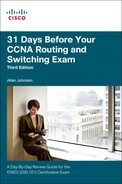Day 10. Troubleshooting EIGRP
CCNA 200-101 ICND2 Exam Topics
![]() Troubleshoot and resolve EIGRP problems
Troubleshoot and resolve EIGRP problems
Key Topics
Today wraps up your review of routing troubleshooting with a review of troubleshooting commands and unique considerations for Enhanced Interior Gateway Routing Protocol (EIGRP).
EIGRP Troubleshooting Commands
You’ll find several commands useful when troubleshooting an EIGRP network:
![]() show ip eigrp neighbors: Verifies that the router recognizes its neighbors
show ip eigrp neighbors: Verifies that the router recognizes its neighbors
![]() show ip route eigrp: Verifies that the router learned the route to a remote network through EIGRP
show ip route eigrp: Verifies that the router learned the route to a remote network through EIGRP
![]() show ip protocols: Verifies the currently configured EIGRP values for various properties of any enabled routing protocols
show ip protocols: Verifies the currently configured EIGRP values for various properties of any enabled routing protocols
![]() show ip eigrp interface: Verifies which interfaces are enabled for EIGRP, the number of peers, and transmit queues
show ip eigrp interface: Verifies which interfaces are enabled for EIGRP, the number of peers, and transmit queues
Figure 10-1 illustrates a method for using these commands in a systematic way.
As with Open Shortest Path First (OSPF) Protocol, neighbor adjacency is a prerequisite to EIGRP convergence and requires Layer 3 connectivity. By examining the output of the show ip interface brief command, you can verify that the status and protocol of connecting interfaces are up. Use show ip protocols (or some other EIGRP-related command) to verify that all routers are configured with the same autonomous system number. Use the show ip eigrp interfaces command to verify that all the necessary interfaces are participating in EIGRP.
You can use the same process to troubleshoot EIGRP for IPv6 implementations. Simply replace the ip with ipv6 in the list of EIGRP-specific show commands:
![]() show ipv6 eigrp neighbors
show ipv6 eigrp neighbors
![]() show ipv6 route eigrp
show ipv6 route eigrp
![]() show ipv6 protocols
show ipv6 protocols
![]() show ipv6 eigrp interface
show ipv6 eigrp interface
Discontiguous Networks
EIGRP has a unique problem because you can configure EIGRP to automatically summarize at the classful boundary. Automatic summarization does not cause any problems as long as the summarized network is contiguous rather than discontiguous. If automatic summarization is enabled in a discontiguous network, you will have a less-than-full convergence situation.
Even a contiguous network design can become discontiguous if one or more link failures divide a classful network into two or more parts. Figure 10-2 shows an internetwork with two contiguous classful networks: 10.0.0.0 and 172.16.0.0.
In this figure, with all links up and working and automatic summarization in effect, all hosts can ping all other hosts. In this design, packets for network 172.16.0.0 flow over the high route, and packets for network 10.0.0.0 flow over the low route.
If any link between the routers fails, however, one of the two classful networks becomes discontiguous. For example, if the link between R3 and R4 fails, the route from R1 to R4 passes through subnets of network 172.16.0.0, so network 10.0.0.0 is discontiguous. The solution is to either design the network in a way that would avoid the possibility of discontiguous subnets or disable automatic summarization and manually configure summary routes.



